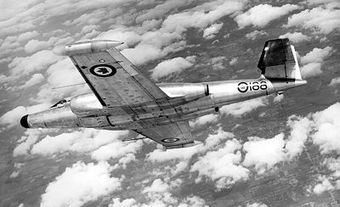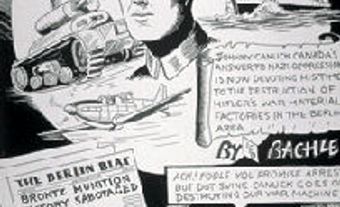“Canuck” is a nickname for a Canadian — sometimes bearing a negative implication, more often wielded with pride. It goes back at least as far as the 1830s, and its meaning has changed over time. The word “Canuck” may be most familiar today as the name of a National Hockey League franchise, the Vancouver Canucks (see British Columbia). In the 20th century, the term enjoyed a much broader use.

Where Does the Word “Canuck” Come From?
The roots of the word “Canuck” are complex, elusive and go back at least as far as the early 19th century.
The most commonly held belief in the past — and still credited in the Canadian Oxford Dictionary — is that Canuck owes its origin to the first syllable of the name “Canada.” “Canadian” is a four-syllable word, and speakers of English often abbreviate such lengthy adjectives to create terse expressions like “Aussie,” “Yank,” “Brit,” and so on. If that is the case, the ultimate root of “Canuck” would be the first syllable of the Iroquoian word “kanata,” or settlement — a village that gave its name to an entire country (see Iroquois and The Origin of the Name Canada).
Many historians and linguists now hold a different view. The 2017 edition of the Dictionary of Canadianisms on Historical Principles argues that — unlikely though it sounds — the direct origins of “Canuck” lie not in Canada, nor in Europe, but in Hawaii. This belief has gained wide acceptance of late.
Two centuries ago, the mainstay of the Hawaiian economy was whaling. Sailors from Hawaii and other Polynesian islands worked on many of the big whaling ships that set out from the northeastern coast of the United States. As a result, the Hawaiian word for a human being — “kanaka” — jumped into American English. On the Pacific Rim of North America, “kanaka” clearly referred to Hawaiians, as in a statement written from Alaska in 1883: “There are a few Hawaiian words introduced by the Kanaka sailors on the whaleships.” But along the US Atlantic coast, where Hawaiian men were fewer in number, “kanaka” took a different meaning. It quickly became a slang expression that could be hurled at any foreigner, especially one who had a darker skin colour than Americans of British or Irish origin.
That applied to Polynesian sailors, and to many people from Lower Canada, or present-day Quebec, particularly those with a mixture of French and Indigenous ancestry. (The word Canadien, at the time, referred exclusively to a speaker of French.) East and south of the Great Lakes, “Canuck” shed its Hawaiian past and became a term for a Canadian, particularly one who spoke French. The word entered the printed record in 1835 in the pages of a book by a British traveller named Henry Cook Todd. In his Notes upon Canada and the United States, Todd mentioned an American who “distinguishes a Dutch or French Canadian, by the term Kanuk.” Their foreignness, their shade of skin, and their language all made them suspect. At that point, “Canuck” was not a word that Canadians used to describe themselves.
DID YOU KNOW?
In 1910, the British adventurer T. E. Lawrence — later to become famous as “Lawrence of Arabia” — shared a passage by ship through the Mediterranean with a trio of French-Canadian clerics whom he described as “the three Canuck priests.” A Canadian-led raid against Fascist troops in northern Italy in January 1945 had the name “Operation Canuck.” And the phrase “Crazy Canucks” was commonly used to identify Ken Read, Dave Irwin and three other male athletes who fearlessly raced in alpine ski competitions for Canada in the late 1970s and early 1980s (see Steve Podborski).
Who is a “Canuck”?
The American usage soon spread north across the border. In his 1866 book Canadian Summer Evening Tales, the Scottish-Canadian journalist and travel writer Andrew Learmont Spedon contrasted a “fat-blooded Englishman” with “that Canuck Frenchman,” a “blasted scoundrel” full of “impertinence and Canuck lingo.” To many people in the mid-19th century, Canuck was merely a casual synonym for French-Canadian — and like the nicknames for people of various other ethnicities or nationalities, it came with unpleasant overtones. The word is “used vulgarly and rather contemptuously,” observed the author of a paper in Canadian Naturalist and Geologist in 1861. This usage of the term was slow to take off west of the Rockies, where the Hawaiian links between “Canuck” and “kanaka” lingered on.
As the decades passed, a Canuck became simply a Canadian — regardless of language, ethnic heritage or skin colour. Occasionally, the word served as a nickname not only for Canadian people but also for the Canadian horse — one of the major breeds of horse in North America during the mid-19th century. The term had once been an example of American scorn, but Canadians were ready to transform that scorn into pride. It became a nickname Canadians applied to themselves.
National Symbolism: From Confederation to the Second World War and Beyond
Johnny Canuck (occasionally also “Jack Canuck” or “Young Canuck”) came to serve as the recognized Canadian equivalent of Uncle Sam in the United States or John Bull in Great Britain: a fictional male figure who personifies the nation as a whole. All three of these figures are patriotic, assertive and proud; they accept insults from no one.
Johnny Canuck sprang to life in 1869, two years after Confederation, when the threat of invasion from the United States was still a concern. A cartoon in a Montreal humour magazine named Grinchuckle showed a stalwart, honest young hero kicking the conniving Uncle Sam back across the border. Johnny Canuck continued to be depicted in newspapers and magazines from time to time over the next 70 years, but only in the Second World War did his image become famous across the country: a young cartoonist named Leo Bachle portrayed him as a barrel -chested, broad-shouldered fighter against the Nazis in a “Dime Comic” from 1942.

A smiling “Miss Canada” or “Janey Canuck” appeared beside Johnny Canuck in some of these drawings. The cartoonists portrayed Janey Canuck as an embodiment of female virtue. “Janey Canuck” was also the pen name of the Alberta author and women’s rights activist Emily Murphy.
The character of Johnny Canuck re-emerged amid the nationalist ferment of the mid-1970s when the Toronto playwright Ken Gass, artistic director of the Factory Theatre, wrote a satirical play named Hurrah for Johnny Canuck! At about the same time, a new superhero made his grand entry in the realm of comic books: Captain Canuck, complete with a helmet and belt adorned by the maple leaf flag. (See also Comic Books in English Canada.)
Canada Post celebrated Bachle’s Johnny Canuck in 1995, in a series of stamps showing Canadian comic book heroes. On the Johnny Canuck stamp, the hero is dressed for battle in a flight jacket, goggles, boots and a leather aviator helmet. While Canadians like to see themselves as a peaceful nation, they also appreciate the muscle power that Johnny Canuck embodies. The choice of image for the stamp recalls the fact that the first jet fighter designed and built in Canada had the name “Avro CF-100 Canuck.”

Contemporary Use of the Word
Canadian nationalism has drawn on the word “Canuck” ever since Confederation, and particularly the visual images of Johnny and Janey Canuck. “Uncle Sam” is not always depicted kindly in these drawings; the United States is sometimes portrayed as an ally, sometimes an adversary. Likewise, in the United States, the old derision against “Canucks” may never have entirely vanished. In 2002, when the right-wing political commentator Pat Buchanan wanted to denounce Canada for being, as he saw it, soft on terrorism, he coined the phrase “Soviet Canuckistan.” To some extent the word “Canuck” remains a contested idiom: people’s views of both Canadian and American nationalisms play a role in how they regard and use the term.

 Share on Facebook
Share on Facebook Share on X
Share on X Share by Email
Share by Email Share on Google Classroom
Share on Google Classroom



